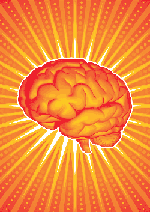| Magazine Home I Links I Contact Us |
|
Home |
Split Brain Studies
Split-brain is a lay term describing the result when the corpus callosum connecting the two hemispheres of the brain is severed to some degree. The surgical operation to produce this condition is called corpus callosotomy (not to be confused with colostomy) and is usually used as a last resort to treat otherwise intractable epilepsy. William van Wagenen, a neurosurgeon, discovered in 1940 that by severing the corpus callosum he could decrease the incidence of seizures in patients with epilepsy. In 1964, Roger Sperry investigated this split-brain technique further. Sperry found that the operation had little effect on general intelligence, personality, temperament and memory. Unconvinced that this operation could leave a patient with such minimal effects, Sperry designed techniques such as the visual half-field experiment to detect differences between split-brain and ‘whole brain’ people. An example of this would be to flash a picture to the left or to the right of the visual field. The nerve fibres from the eye cross at a point called the optic chiasm, which implies that what you see in the left visual field will go to the right side of the brain for processing and vice versa. When split-brain patients were asked to report what they saw when a picture was flashed in the right visual field, they could easily identify and report verbally on the picture they had seen. However, they experienced problems when pictures were flashed in the left visual field. Remember that Broca’s area is responsible for speech production, and is found in the left frontal lobe. If a picture is flashed in the left visual field, it would be projected to the right hemisphere, which is not dominant for speech, and we would expect the problem of patients not being able to name what they see. Sperry and Gazzaniga, another neuroscientist, gave a split-brain patient a set of four blocks with surfaces that had different colours and patterns. They asked the patient to arrange the blocks to match the patterns on the cards. They observed that the patient could complete the task easily with the left hand, but not with the right, which indicates the right hemisphere’s superior spatial ability. |
| Home A B C D E F G H I J K L M N O P Q R S T U V W X Y Z |